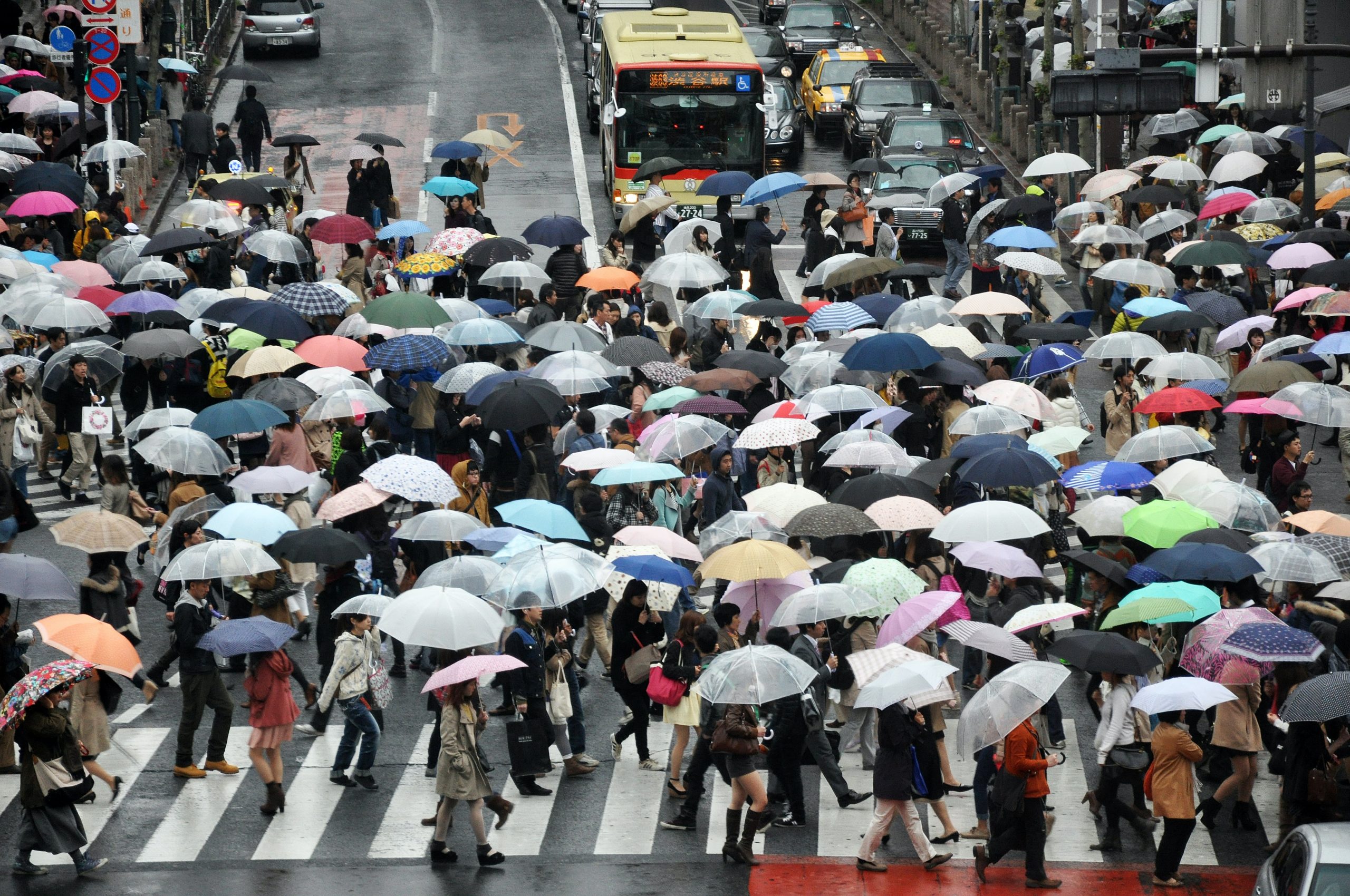52 East Asia
How do we define the region?
As we have with other regions, as geographers we seek to group similarities together in a region. What do we find that makes a coherent East Asia?
 First, we are not going to get away from that fact that the size of China dominates the region. China’s population of about 1.4 billion people dwarfs the other countries of East Asia; for instance, Japan is second largest at 125 million people. In area, China’s 3.7 million square miles place it among the world’s five largest countries. In East Asia, the next largest country again is Japan, at 146 thousand square miles. So, by the numbers, China’s population is more than ten times larger than Japan’s population, while China’s area is more than twenty-five times bigger than Japan’s area.
First, we are not going to get away from that fact that the size of China dominates the region. China’s population of about 1.4 billion people dwarfs the other countries of East Asia; for instance, Japan is second largest at 125 million people. In area, China’s 3.7 million square miles place it among the world’s five largest countries. In East Asia, the next largest country again is Japan, at 146 thousand square miles. So, by the numbers, China’s population is more than ten times larger than Japan’s population, while China’s area is more than twenty-five times bigger than Japan’s area.
Second, we always examine culture when we strive to define regions. In terms of languages, East Asia features that Sino-Tibetan language family primarily. The Sino-Tibetan language family includes Chinese, thus spoken by far the most people in East Asia. There are several dialects of Chinese with Mandarin being the most common at about 65% of Chinese speakers. In China there are over six million Tibetan peoples about 45% of whom live in the Tibetan province. These people speak various Tibetan languages and dialects, though still within the Sino-Tibetan language family. In Taiwan, Mandarin and Taiwanese Hokkien both are spoken by over 80% of the population.
Although Japanese language must have historical links with Chinese language, as seen by the use of their character-based scripts, Japanese is distinctly different as to have its own language family.
While a glance at Korean script may suggest links with Chinese and Japanese, Korean language is so distinctive that linguists categorize it as a language isolate, that is, as a language unrelated to any other language. Strikingly, as a language isolate, Korean is spoken by more people than all other language isolates combined.

So, to summarize the languages of East Asia, we have the Sino-Tibetan languages that predominate in China, plus the distinctive Japanese and Korean languages.
Third, there is religion. East Asia is noteworthy for its Taoism, Confucianism, and Shintoism. These practices differ from the faiths of Christianity, Islam, and Judaism in that these Eastern traditions do not feature a divinity, but instead focus on virtue, natural order, and moral action. Religion adherence is made more complex by the Chinese communist state’s somewhat passive atheism and by North Korea’s very harshly promoted anti-religious attitude. South Korean surprises with Christianity drawing about a quarter of the population.

Fourth, this is a very crowded region. Population density (people per square mile (or per square kilometer, as in most of the world)) is a tricky statistic for comparison. Statistics for city-States like Monaco or Singapore needs to be discarded, for these are cities that are countries at the same time, thus lacking rural areas. Tiny island countries like Malta or the Maldives often have inflated population densities, as they have very limited areas. Desert countries usually have low population densities. Who lives in the desert? Highly mountainous countries too have low population densities. Who lives on mountain slopes? East Asia has some of these characteristics.
If we eliminate micro-States, city-States, and small island countries, then Bangladesh in South Asia is the world’s most crowded country with about 2800 people per square mile. What about East Asia? Here is a table that looks at these numbers.
| Country | Population Density | Factors | Physiological Density |
|---|---|---|---|
| Taiwan | 1689 | Island and some mountains | 9994 |
| South Korea | 1323 | some mountains | 9074 |
| Japan | 872 | islands and some mountains | 7491 |
| North Korea | 549 | some mountains | 2812 |
| China | 385 | large western desert, many western mountains | 3041 |
| USA | 88 | southwestern desert, many western mountains | 528 |
| Mongolia | 5 | mountains and desert | 1351 |
Physiological density is the number of people per unit area of arable land. This may be a more useful measure than simple population density in that it realizes that desert and mountainous lands are not useful for population settlement. The table above shows that these numbers are high for East Asia.
Fifth, economic tigers. China and Japan long have been economic powers. East Asia also holds three of the four so-called “economic tigers” of Asia. These are Taiwan, South Korea, Hong Kong (semi-autonomous city of China), as well as Singapore in Southeast Asia. Big or small, these countries have major manufacturing and trade, except for weak link North Korea.
Sixth, East Asia features a mix of communism and advanced democracies with Hong Kong and its neighbor city of Macau being noteworthy points of intersection. China and North Korea run their versions of communism, while Japan, South Korea, and Taiwan have long-established democracies.
Overall, East Asia features a “YES AND” set of characteristics.
-
China AND a cluster of much smaller countries
-
Sino-Tibetan languages and the distinctive Japanese AND Korean languages.
-
Eastern traditional religions of Taoism, Confucianism, and Shintoism AND a background of Buddhism with a twist of governmental atheism.
-
Highly crowded countries AND more so due to physical geographic limitations.
-
Economic powerhouses of China and Japan AND economic tigers.
-
Communism AND advanced democracies.
Why does Mongolia NOT fit into East Asia?
- Not vastly smaller than China in area.
- Language family is disputed, but may be Altaic, unlike the rest of East Asia.
- 50% Buddhist, but no Taoism, Confucianism, or Shintoism.
- Very sparsely crowded.
- Not an economic tiger, but depends on agriculture and mining.
- New to democracy, after Soviet-style communism.
Instead, we will add Mongolia to Central Asia, where it is a better fit.
Did you know?
How does China’s dominance of East Asia compare with any other country’s dominance of its region? That is, is China’s regional dominance greater than that found in any other region?
What about India? India is more than six times bigger than Pakistan in population and about six times larger in area. Thus, in these fundamental measures, India dominates its region less than China dominates East Asia.
What about Australia? In land area, Australia is about sixteen times bigger than Papua New Guinea and about three times more populated. Again, China wins.
What about Brazil? Brazil has four times as many people as Colombia does, while it has three times the area of Argentina. China wins.
Wait! Have you been shouting – What about Russia? Russia’s area is nearly thirty times larger than Ukraine’s area, while Russia’s population is more than triple that of Ukraine. Here we have a split decision. Russia dominates its region by area more than China does, but China dominates its region by population more than Russia does.
My Turn!
CITED AND ADDITIONAL BIBLIOGRAPHY:
“List of Countries by Real Population Density Based on Food Growing Capacity.” In Wikipedia, July 14, 2021. https://en.wikipedia.org/w/index.php?title=List_of_countries_by_real_population_density_based_on_food_growing_capacity&oldid=1033504964.
Wiertz, Steve. East Asia. College of DuPage GIS Class. May 2022.


